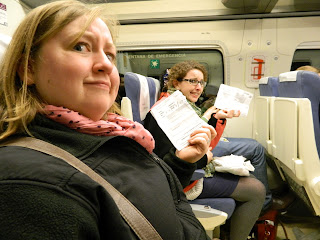I live in the middle, in Madrid, in medieval remnants. The buildings are stocky; the earth is dry. Madrid is filled with the ghosts of kings, frozen in stone and bronze statues, with old whispers of horse hooves clip-clopping on cobblestone. It is castles and crypts and artisans who picked just the perfect flat rock to fit next to thousands of other flat rocks lining the steps that would point toward a garden that tourists, six hundred years later, would pay 10€ to walk over, never noticing quite how the grit and the gravel fit together so tightly.
The last time I remember rain in Madrid, it was night, it fell only for minutes, I was still not sleeping well. October, maybe. Madrid sees wisps of gray clouds and prays for them to fill the reservoirs; Camarma has been rationing water off and on because it is brown, dusty, dry here. Here in the land of the kings.
At the end of Christmas vacation, I bought a train ticket to Málaga, down on Spain's southern tip. Katrina was patient with me as I pointed out the orange trees on every corner, snapped pictures of water and palm trees and blooming flowers. Flowers! In January! From the top of a steep cobblestone hike, we thought we spied Morocco peeking over the edge of the Mediterranean.
Andalucía, the southernmost region of Spain, is the Spain you see on postcards and travel brochures. The tropical Spain, the Moroccan Spain. The Moors rounded the corners of their windows, their doorways. Stars are interwoven in the woodworking. It is warmer there, still ancient, but of a different flavor. You don't sense the merchants and lords and ladies on horseback as much. They are women in head coverings, stirring spices into Moroccan soup--as far from Madrid as you can get, with its bland sauces. You taste fruit and color; you are gathered into rhythm and unfurled into Arabic script, and it is just as much like Spain as you'd ever imagined.
During February's winter break, Sarah, Caitlin, and I rented a cheap hostel room in Sevilla, also part of Andalucía. We had lumpy mattresses and a roommate who asked Caitlin to borrow her deodorant at 7am, but other than that, Sevilla smelled like spring.
Sevilla is Christopher Columbus' burial site, a marriage of Gothic and Moorish, an Islamic mosque turned Catholic cathedral, an intricate carving stamped with a Spanish coat-of-arms. It is so many different kinds of history linking together in patterns that don't match and won't match and somehow still do match.
(Actually, the mosque-cathedral is in Córdoba, which is north of Sevilla. But still in Andalucía.)
The fence is ceramic. CERAMIC. The fence is ceramic, the plaza has a moat around it, and we were surrounded by sour orange trees. In all of Spain, Sevilla is my favorite, like a rainbow hand-wrung over summer sky. Even when our train tickets say "Coche 9" and there are only five cars.
Bilbao is too modern for Madrid, too chilly for Sevilla, too northern-European to be Spain, and yet...it's Spain. It's all Spain, all these wonderful handfuls of mismatched foliage sprinkled across a giant peninsula that's at once dry and drenched. God is pressed into every inch of it, and you can see his tender care in the raindrops that splatter across the Basque Country, just as evident as it is in the apple blossoms that sway over dust clouds as I look out my classroom window. He is here in breeze and dust and drought, and I cannot help but fall in love with this country I never expected to live in, on a continent I was never that interested in, visiting cities I'd never thought about.
But it's so full and it's so beautiful, and He comes squeezing out of the middle of everything, and sometimes I wonder if I could explode from trying to take it all in.






























No comments:
Post a Comment